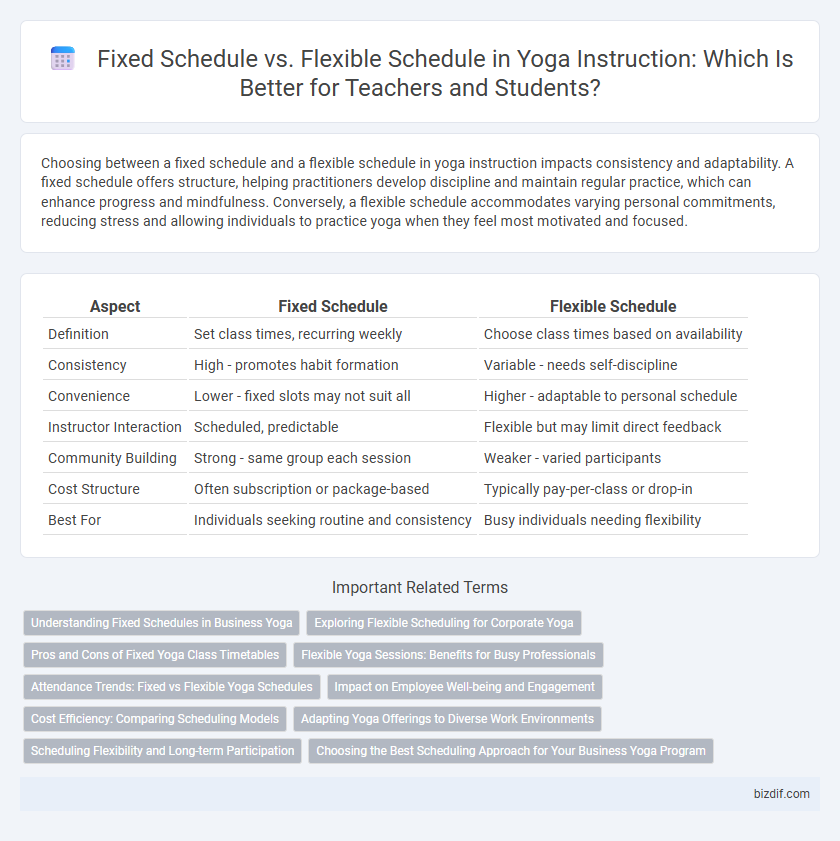Choosing between a fixed schedule and a flexible schedule in yoga instruction impacts consistency and adaptability. A fixed schedule offers structure, helping practitioners develop discipline and maintain regular practice, which can enhance progress and mindfulness. Conversely, a flexible schedule accommodates varying personal commitments, reducing stress and allowing individuals to practice yoga when they feel most motivated and focused.
Table of Comparison
| Aspect | Fixed Schedule | Flexible Schedule |
|---|---|---|
| Definition | Set class times, recurring weekly | Choose class times based on availability |
| Consistency | High - promotes habit formation | Variable - needs self-discipline |
| Convenience | Lower - fixed slots may not suit all | Higher - adaptable to personal schedule |
| Instructor Interaction | Scheduled, predictable | Flexible but may limit direct feedback |
| Community Building | Strong - same group each session | Weaker - varied participants |
| Cost Structure | Often subscription or package-based | Typically pay-per-class or drop-in |
| Best For | Individuals seeking routine and consistency | Busy individuals needing flexibility |
Understanding Fixed Schedules in Business Yoga
Fixed schedules in business yoga provide consistent class times that foster routine and reliability for clients, enhancing commitment and attendance. These scheduled sessions help streamline instructor planning and optimize resource allocation by establishing predictable demand patterns. Maintaining a fixed timetable supports building a dedicated community and simplifies marketing efforts through regular, anticipated offerings.
Exploring Flexible Scheduling for Corporate Yoga
Flexible scheduling for corporate yoga enhances employee participation by accommodating diverse work hours and reducing stress through personalized class timings. This approach supports improved productivity and wellness by fitting seamlessly into hectic corporate calendars, allowing employees to engage in sessions that best suit their individual energy levels. Organizations implementing flexible yoga programs report higher attendance rates and greater overall satisfaction among staff, boosting workplace morale and health outcomes.
Pros and Cons of Fixed Yoga Class Timetables
Fixed yoga class timetables provide consistent routine and structure, helping practitioners build discipline and easily integrate sessions into their daily schedule. These scheduled classes create a community environment that boosts motivation and accountability among participants. However, fixed times may restrict flexibility, potentially leading to missed sessions due to conflicting commitments or unexpected changes in availability.
Flexible Yoga Sessions: Benefits for Busy Professionals
Flexible yoga sessions accommodate busy professionals by allowing practice at convenient times, reducing stress and enhancing consistency. This adaptability supports better work-life balance and promotes sustained physical and mental well-being. With personalized scheduling, participants can maintain regular yoga habits despite fluctuating work demands, improving overall health outcomes.
Attendance Trends: Fixed vs Flexible Yoga Schedules
Fixed yoga schedules tend to show consistent attendance patterns, with practitioners committing to regular class times that support routine and discipline. Flexible schedules attract a wider range of participants by accommodating variable availability, often leading to fluctuating attendance depending on individual preferences and external commitments. Attendance trends reveal that studios offering both options can optimize engagement by balancing structure with adaptability to meet diverse client needs.
Impact on Employee Well-being and Engagement
Fixed schedules in yoga instruction provide consistency that supports employee well-being by establishing routine and reducing uncertainty, which enhances focus and stress management. Flexible schedules offer greater autonomy, allowing instructors to balance personal commitments and reduce burnout, leading to higher engagement and job satisfaction. Both approaches impact mental health and motivation differently, requiring yoga studios to assess their staff's unique needs for optimal performance and retention.
Cost Efficiency: Comparing Scheduling Models
Fixed schedule yoga classes often offer greater cost efficiency due to predictable attendance and streamlined instructor hours, reducing overhead costs for studios. Flexible scheduling may increase operational expenses by requiring more administrative coordination and variable instructor availability, leading to higher costs per session. Studios must analyze attendance patterns and resource allocation to determine which scheduling model maximizes profitability without compromising class quality.
Adapting Yoga Offerings to Diverse Work Environments
Adapting yoga offerings to diverse work environments requires balancing fixed and flexible schedules to meet varying employee needs. Fixed schedules provide consistency and structure, ideal for routine-driven workplaces, while flexible schedules offer personalization and accessibility for dynamic or remote teams. Incorporating both approaches enhances participation, supports mental well-being, and accommodates fluctuating work demands effectively.
Scheduling Flexibility and Long-term Participation
Flexible scheduling in yoga instruction enhances long-term participation by accommodating diverse lifestyles and reducing barriers to consistent practice. Fixed schedules may benefit individuals with routine preferences but can limit attendance flexibility and deter communal commitment over time. Prioritizing scheduling flexibility supports sustained engagement, fostering improved physical health and mental well-being among yoga practitioners.
Choosing the Best Scheduling Approach for Your Business Yoga Program
Choosing the best scheduling approach for your yoga business impacts client retention and operational efficiency significantly. Fixed schedules create consistency and help build a loyal community by setting clear expectations for class times, while flexible schedules cater to diverse lifestyles and improve accessibility for clients with varying availability. Analyzing client demographics and preferences alongside instructor availability ensures an optimized balance between structured programming and adaptable options for growth.
Fixed schedule vs Flexible schedule Infographic

 bizdif.com
bizdif.com